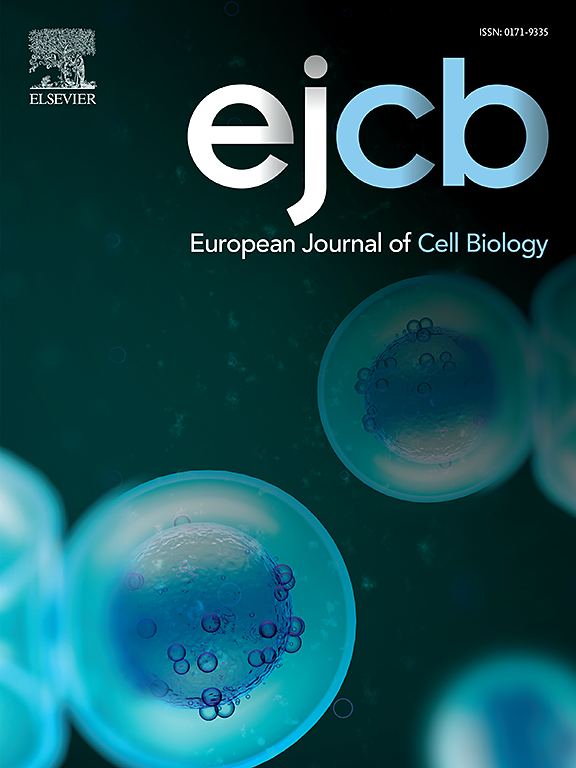内皮细胞Piezo1促进大动脉血管平滑肌细胞分化。
IF 4.3
3区 生物学
Q2 CELL BIOLOGY
引用次数: 0
摘要
血管稳定是一个机械敏感的过程,部分是由血流驱动的。在这里,我们证明了机械敏感离子通道Piezo1在促进斑马鱼发育过程中血管平滑肌细胞(vSMCs)的动脉积累中的作用。使用一系列小分子拮抗剂或激动剂暂时调节Piezo1活性,我们确定了Piezo1通道在调节血流响应转录因子klf2a,表达水平和动脉和静脉之间vSMCs靶向改变中的作用。增加Piezo1活性可抑制klf2a并增加与主静脉的vSMC关联,而抑制Piezo1活性可增加klf2a水平并降低与动脉的vSMC关联。我们在斑马鱼体内遗传抑制piezo1和2,从而导致背主动脉上transgelin+ vSMCs的丢失,从而支持小分子研究结果。此外,小鼠内皮细胞(EC)特异性敲除Piezo1足以减少发育过程中沿降背主动脉的vSMC积累,从而表型复制了我们的斑马鱼数据,并支持了Piezo1在哺乳动物中的功能保护。为了确定潜在的机制,我们使用体外模型分析来证明内皮细胞对脉动力和层流力的差异感知改变了壁细胞分化基因的表达。综上所述,我们的研究结果表明,EC Piezo1在大动脉内感知力,介导壁细胞分化和动脉血管稳定方面发挥了关键作用。本文章由计算机程序翻译,如有差异,请以英文原文为准。
Endothelial cell Piezo1 promotes vascular smooth muscle cell differentiation on large arteries
Vascular stabilization is a mechanosensitive process, in part driven by blood flow. Here, we demonstrate the involvement of the mechanosensitive ion channel, Piezo1, in promoting arterial accumulation of vascular smooth muscle cells (vSMCs) during zebrafish development. Using a series of small molecule antagonists or agonists to temporally regulate Piezo1 activity, we identified a role for the Piezo1 channel in regulating klf2a, a blood flow responsive transcription factor, expression levels and altered targeting of vSMCs between arteries and veins. Increasing Piezo1 activity suppressed klf2a and increased vSMC association with the cardinal vein, while inhibition of Piezo1 activity increased klf2a levels and decreased vSMC association with arteries. We supported the small molecule findings with in vivo genetic suppression of piezo1 and 2 in zebrafish, resulting in loss of transgelin+ vSMCs on the dorsal aorta. Further, endothelial cell (EC)-specific Piezo1 knockout in mice was sufficient to decrease vSMC accumulation along the descending dorsal aorta during development, thus phenocopying our zebrafish data, and supporting functional conservation of Piezo1 in mammals. To determine the underlying mechanism, we used in vitro modeling assays to demonstrate that differential sensing of pulsatile versus laminar flow forces across endothelial cells changes the expression of mural cell differentiation genes. Together, our findings suggest a crucial role for EC Piezo1 in sensing force within large arteries to mediate mural cell differentiation and stabilization of the arterial vasculature.
求助全文
通过发布文献求助,成功后即可免费获取论文全文。
去求助
来源期刊

European journal of cell biology
生物-细胞生物学
CiteScore
7.30
自引率
1.50%
发文量
80
审稿时长
38 days
期刊介绍:
The European Journal of Cell Biology, a journal of experimental cell investigation, publishes reviews, original articles and short communications on the structure, function and macromolecular organization of cells and cell components. Contributions focusing on cellular dynamics, motility and differentiation, particularly if related to cellular biochemistry, molecular biology, immunology, neurobiology, and developmental biology are encouraged. Manuscripts describing significant technical advances are also welcome. In addition, papers dealing with biomedical issues of general interest to cell biologists will be published. Contributions addressing cell biological problems in prokaryotes and plants are also welcome.
 求助内容:
求助内容: 应助结果提醒方式:
应助结果提醒方式:


